Ringing the Bull: Testing the Lamborghini Aventador SV's New Rear-Wheel Steering at the 'Ring
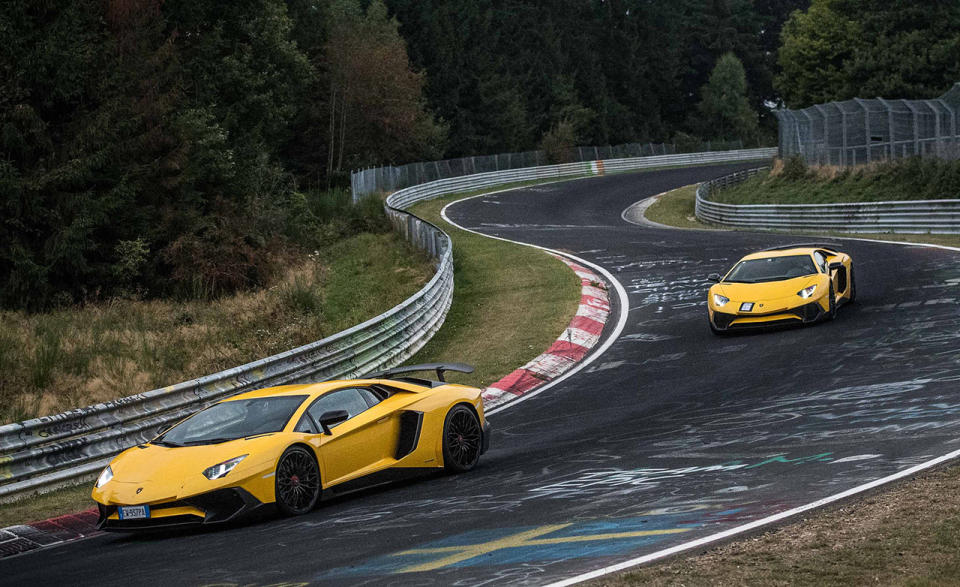
From the December 2016 issue
Mario Fasanetto goes shrieking through the forests of the Eifel Mountains in a Lamborghini Aventador SV, a car that seemingly came about when Clark Kent and the devil had a baby. The Lambo’s body is slashed with cuts and gouged with holes and tattooed with black blades that order the wind to either go through it or around it. The four pipes under the rear origami “bumper” gush blue flame—flame!—a good six inches when the whip comes down on the 6.5-liter, 8500-rpm V-12. This is the car that appears when you call for an Uber in Mordor.
Today is one of those special days when being a car-magazine editor is exactly what everyone thinks it’s like all the time. We’re behind Fasanetto, Lamborghini’s chief test driver, trying to keep up, two ham-handed journalists foolishly given our own 740-hp SVs. One is virtually identical to Fasanetto’s stock all-wheel-drive SV, and the other is a prototype with some experimental new gear. All three cars are giant roaring pancakes of fury, ready to rapidly convert a mistake into a long, smeary sculpture of bent and blackened guardrail dusted by shattered carbon fiber. It starts to rain.
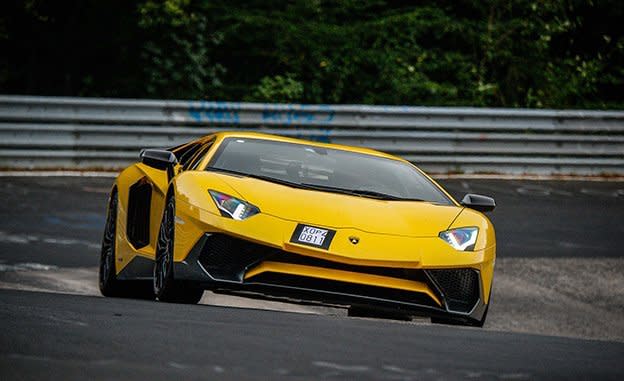
In the briefly innocent interlude between the wars, some long-ago lumberjacks cut a deep trench through the leafy blanket of beech and oak and perfumed pines here in northwest Germany and along came the Nürburgring. The workers got the privilege of naming some of the corners, such as Fuchsröhre, which honors a fox that refused to be dislodged during the construction, and Galgenkopf, the former site of a gallows where the ancient Earls of Nürburg held public hangings. Say what you will about the Brickyard and its century of history, there are no monuments at Indy to stuff that happened in the 17th century as there is at Schwedenkreuz, where a cross marks the spot where Swedish soldiers assassinated a local mayor in 1638.
Jackie Stewart gave the Nürburgring a permanent christening when he called the Nordschleife the “Green Hell.” He wasn’t trying to be glib; blood paints the road from one end to the other. Today the vast facility, dark and moody under a threatening sky, is nearly empty except for the three of us and some participants in a one-day track experience, called Lamborghini Accademia, hosted by Lambo’s Squadra Corse motorsports department.
We’ve been summoned to sample a prototype Aventador SV with four-wheel steering that acts upon revised suspension geometry. Lamborghini has been camped out here for some time already, based out of a cozy chalet in the village of Nürburg near the famous Pistenklause restaurant, where racing greats have autographed the walls and ceiling. As you may have guessed already, this isn’t anything like the slow-mo Bugatti Chiron development drive; at one point your author saw 186 mph.
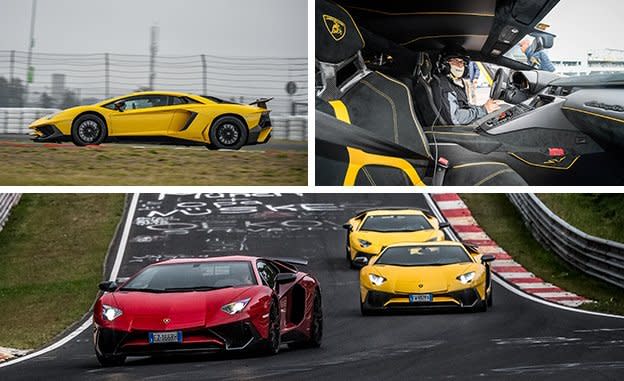
The work of development engineers isn’t always tedious. Sometimes, it involves beating Aventadors on the Nürburgring. Good work, if you can find it.
Besides the rear steering, the experimental Aventador also has a new giant 10.1-inch touchscreen with the usual grab bag of functionality found in today’s units, from web radio to Apple CarPlay. It’s all beautifully presented via a high-res, multicolor interface, but if you’re thinking that such features seem as superfluous in a Lamborghini as they seem necessary in a Toyota Camry, you’re not alone. Are Aventador owners really clamoring for Spotify to relieve the monotony of their daily commute? Probably not, but Lamborghini figures that a car with a base price nipping at half a million dollars ought to at least offer the same equipment as cars costing one-twenty-fifth as much.
Lamborghini has already announced rear steering on the special-edition $2 million Centenario, of which 40 will be built. But the brand seems eager to filter the technology down, especially to the Aventador, a car that weighs 3900 pounds in its lightest SV form and feels as big as a Fountain Powerboat. In back, the usual toe-control links are replaced by two individual motorized control units from Germany’s ZF that can rapidly swing the barrel-like 355-section Pirellis through a six-degree sweep. It is indeed rear steering, but as with most such setups, perhaps it’s more appropriate to think of it as dynamic toe adjustment. Lamborghini also installed a new aluminum hub carrier in back that changes the rear geometry, building in more camber change and reducing caster. The changes promise to make the prototype rear axle one lively place indeed.
Lamborghini not only rented the 12.9-mile Nordschleife, it also took over the much newer, 3.2-mile Grand Prix circuit, famous for its giant Mercedes-Benz star looming over the stadium area and its history of curb-jumping DTM slugfests. We start here, lifting those scissor doors that are still crazy and cramming into the SV’s unforgiving seat shells, our helmeted heads rammed into the low ceiling. To start an Aventador, you flip up a red button cover that looks as if it came out of a Minuteman silo and then put fire to the V-12.
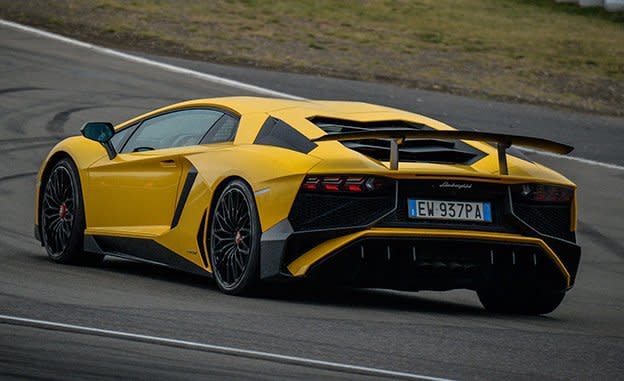
It’s been a long time since a V-12 dominated any serious form of racing. Formula 1 bid adieu in 1996. Peugeot put the last V-12 on the Le Mans podium in 2009; now that the top class is hybrids, we’re unlikely to ever see another. Thus, there’s a lot of romantic history balled up in the sound of the Aventador’s perfect dozen. Let your imagination go and a wailing Matra MS11 explodes from the Monte Carlo tunnel, or a Ferrari 330 P4 rips the night at Daytona, or Jaguar’s purple-and-white Silk Cut XJR-12 thunders down the Mulsanne with Porsche 962s giving futile chase. Until very recently, Lamborghinis raced hardly at all and never successfully, so it’s somewhat ironic that its Aventador is one of the few cars today that preserves the faith.
We blast out, passing under the unblinking monocle of that looming Mercedes star. On the GP circuit’s tight corners, the differences in the prototype would be apparent even to someone who drives mining trucks for a living. With the rear wheels brought to life, the wide SV turns more eagerly and is easier to adjust midcorner, letting you trace a very fine scalpel line. The massive sled of a car shrinks around you. The regular SV is no airport bus, but it wears more like a nicely tailored jacket and slacks compared with the prototype, which is a wetsuit. Throttle, brake, turn, throttle, brake, turn; the writhing GP circuit is a workout, but the prototype’s slithery tush means it wants to dive-bomb the apex cones. For anyone who knows Lamborghini, who knows what a dry-lake-bed rod the Diablo drove like, the bull has come a long way.

As with most four-wheel-steering systems, the Lambo’s rear wheels turn in the opposite direction of the fronts at low speed, creating a “virtual shorter wheelbase,” says vehicle dynamics engineer Giuseppe Di Rosa, for a reduced turn radius and more agility in tight corners. At higher speeds, meaning above 60 mph, the wheels go in phase with the fronts, creating, in effect, a longer wheelbase for stability. After a few sessions on the GP circuit, we leap out, singing the praises of the prototype to our beaming hosts.
The murky skies descend a bit. After lunch we take a ride around the GP circuit with a blond, falcon-eyed Dutch racer named Jeroen Mul in a Huracán Super Trofeo from the company’s one-make series, nearly losing our gnocchi to the belt-straining brakes. After that, Lamborghini deems us all ready for the big show, for the Grüne Hölle. So along with the Accademia students, we troop over to the incomparable Nordschleife, a zillion-dollar conga line of Aventadors and Huracáns rendered in all the blazing colors of the Skittle-verse.
The first lap through the forest takes time as we warm up the tires and the nerves and avoid passing the jittery school groups. In places, the track is desert dry; in others, it’s damp. Such is the ’Ring with its varying patchwork of weather. We stop in the pits and I wave off an inquiring Fasanetto, who has been showing us the line and wants to see if we wish to swap cars. Nope, not yet.
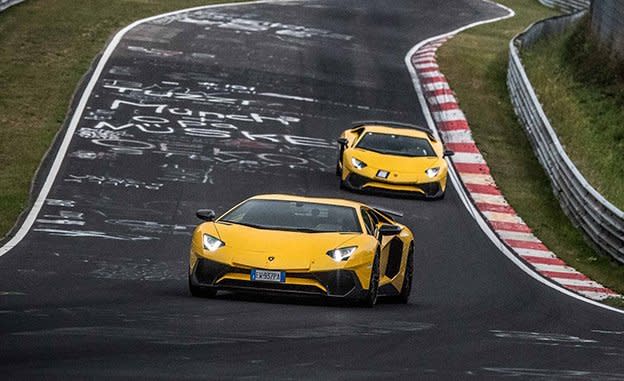
The prototype SV does all the Nürburgring things, going terrifyingly light at the Flugplatz, crashing into the lumpy Caracciola-Karussell, and attacking the curbing in the highly technical section from Wippermann down to the Schwalbenschwanz, the Swallow’s Tail. At 8000 revs, ears are flattened and eyes see stars. And those flames! On the straight, gearchanges banging in one after the other, the SV simply flies, the speedo creeping just past 300 km/h (186 mph) as the gentlest of kinks at Tiergarten comes up so fast that it feels like . . . like—wait, something’s wrong.
The newfound slash that the prototype displays on the tight GP circuit emerges as a nervous hyperactivity on the faster Nordschleife. We swap cars, then swap again, confirming impressions. Yes, the regular SV is more secure, more planted, less work, less white-knuckled at the triple-digit Tiergarten and elsewhere. Feeling more confident, we drive harder in the regular SV. Upon retiring to the pits, we deliver our observations and the engineers nod; apparently this is not news and there’s still work to do. Enlivening the rear with steering and new geometry comes with trade-offs, and, as with everything in automotive engineering, the art is in finding the best compromise.
Lamborghini is coy on when we’ll see rear steering in something besides the Centenario, allowing only that it’s been working on it for two years. That’s a lot of laps at the ’Ring, and there are more to come. If they’re looking for volunteers, we’re in, even if it takes another 10 years.
Explained: Rear Steering and “Virtual” Wheelbase

Specifications >
VEHICLE TYPE: mid-engine, all-wheel-drive, 2-passenger, 2-door coupe
ESTIMATED BASE PRICE: $500,000
ENGINE TYPE: DOHC 48-valve V-12, aluminum block and heads, port fuel injection
Displacement: 397 cu in, 6498 cc
Power: 740 hp @ 8400 rpm
Torque: 509 lb-ft @ 5500 rpm
TRANSMISSION: 7-speed automated manual
DIMENSIONS:
Wheelbase: 106.3 in
Length: 190.4 in
Width: 79.9 in Height: 44.7 in
Passenger volume: 50 cu ft
Trunk volume: 5 cu ft
Curb weight: 3900 lb
PERFORMANCE (C/D EST):
Zero to 60 mph: 2.7 sec
Zero to 100 mph: 5.9 sec
Standing ¼-mile: 10.5 sec
Top speed: 217 mph
FUEL ECONOMY (C/D EST):
EPA combined/city/hwy: 13/11/18 mpg

 Yahoo Autos
Yahoo Autos 